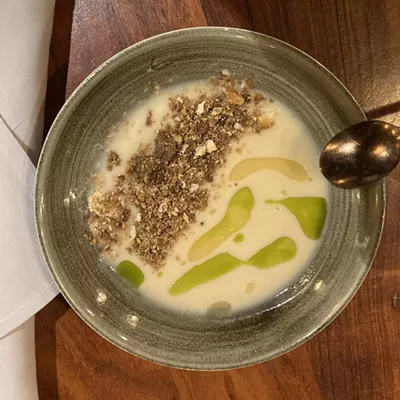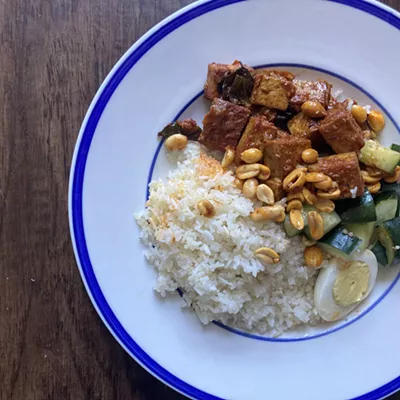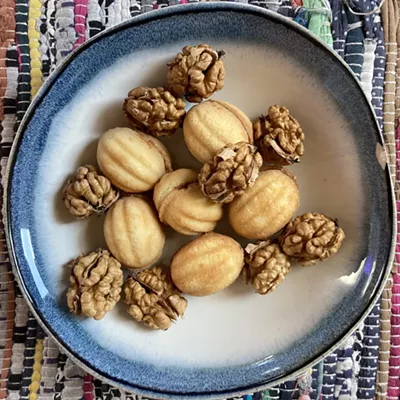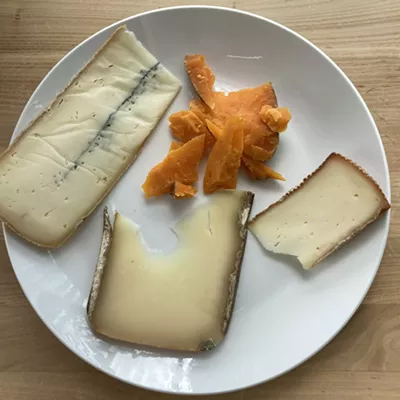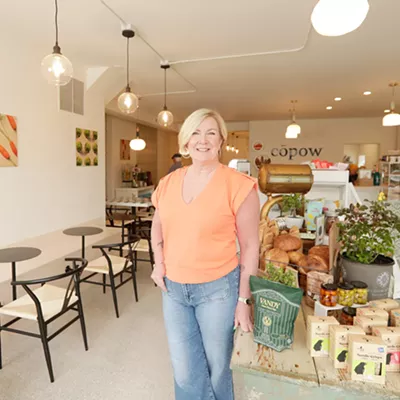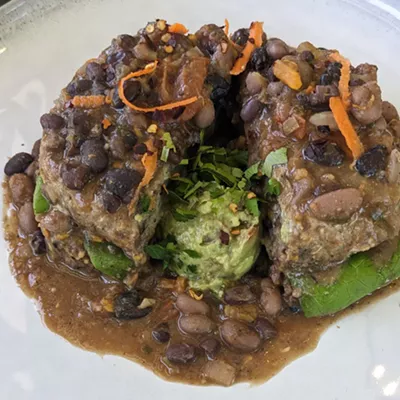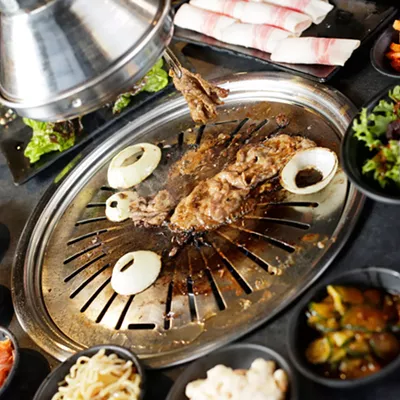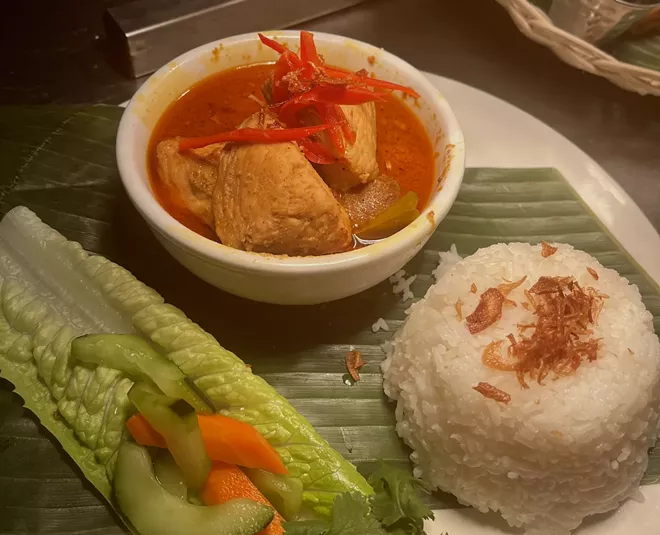
This is an installment of the Inlander's yearlong project "Around the World in 80 Plates," a quest to find 80 foods and drinks in Spokane representing 80 different places. Read the introduction to the project here.
Count of dishes/places: 7
Mida Wayuono has been in Spokane for years, but until recently she avoided making Indonesian food because she couldn't source all the right ingredients. Born in Medan, Sumatra, Wayuono is particular about the spices and herbs used to make the food she ate as a child, like turmeric leaves, galangal and candlenut.
Last month, a friend flew across the Pacific to visit Wayuono. She brought her a precious gift: Indonesian bay leaves, picked fresh from her niece's backyard garden. The unique herbs, and a little extra prodding by Feast World Kitchen, convinced Wayuono to serve Indonesian food for the first time at the international cafe.
On January 21, Wayuono, her daughter Isabella, and her friend Irma brought their favorite Indonesian dishes to Feast. First on the list of entrees was Rendang Ayam in the West Sumatran style.
RENDANG: WEST SUMATRA, INDONESIA
Rendang is a wildly popular dish that has been passed around different Indonesian islands and other Pacific Rim nations like Singapore, the Philippines, and Malaysia, each of which give the stew their own twist. Java's version is sweeter with a teriyaki kick, while Malaysian rendang is often drier than the typical Indonesian stew.
West Sumatran rendang relies completely on herbs and spices, which is why it's so important to get the ingredients right. There are no cinnamon or cloves, which might appear in rendang from Java or Bali. Sumatran food isn't spicy, either, so you can't mask flavors with heat.
"Ayam" means chicken, which Wayuono used in her dish. Other options include beef, fish, egg, squid or shrimp. The most essential ingredient, Wayuono says, is time. Rendang takes a very long time to make. Before her service at Feast, Wayuono cooked for 6 hours overnight, slept for a few hours, and kept cooking first thing the next morning. She toasted shredded coconut and pounded it until it became a dark, aromatic paste. She stewed the meat for hours. The important thing is to let the spices and herbs cook for a long time to make that "magic taste," she says.
Because of the time it takes to make, the rendang of her childhood was reserved for special occasions, Wayuono says. If a family member was coming to visit, her mother would stay in the kitchen the day before, slowly preparing rendang, which would be the perfect welcome. Wayuono learned how to make rendang by watching her mother and older sister make it.
Rendang is also a commonly featured dish when Muslims break the fast at Eid al-Fitr, the end of Ramadan, a public holiday in Indonesia. Typically, families gather around a spectacular array of dishes, ask each other for forgiveness and peace, then dig in. Rendang is on almost every family's table, Wayuono says.
Right now, this West Sumatran rendang isn't regularly available in Spokane since Wayuono's stint at Feast was only one day. But that could change. Wayuono cooks for various events held by Spokane United We Stand, and already has plans for another menu at Feast. On Feb. 11, Feast will celebrate the Lunar New Year by featuring Wayuono's food along with dishes by chefs from Hong Kong and Malaysia. Wayuono is contributing Indonesian-style dim sum called siomay, a steamed fish dumpling served with veggies and peanut sauce. No matter what she makes, Wayuono sticks to her convictions: using the best ingredients, lots of cook time, and a little bit of magic.
TEMPEH: JAVA, INDONESIA
Speaking of ingredients, one of the side dishes Wayuono prepared used a basic ingredient invented in Indonesia that's far less appreciated on this side of the Pacific. Tempeh (pronounced TEMP-ay) is a traditional fermented soybean cake that most likely originated in Eastern or Central Java and is now a staple Indonesian food. In the U.S., it's often mentioned in the same breath as tofu, although the texture and taste are completely different.
Tempeh features soybeans that are almost whole and held together with a dense mycelium — yes, the threads of fungus that also also help mushrooms talk to each other under trees. The soybeans ferment and create a very dense, nutty cake that can be steamed, baked or fried. (While tofu was created in colder climates like China and Japan, the heat and humidity in Java led to fermentation, and thus tempeh, pretty quickly.)
Though tofu fans love to brag about how easily tofu takes on other flavors, tempeh takes a little more time to do so. Wayuono says it's best to steam and then marinate it in order for the flavors to really sink in. Deep frying or sticking small pieces in the air fryer make tiny nuggets of nutty, crispy goodness, perfect for dipping or putting on salads. It packs a serious punch of protein, and probiotics from fermentation are constantly touted these days as good for gut health.
Every day when Wayuono came home from school, tempeh, tofu, fish and soup would already be waiting for her as an afternoon snack. The tempeh she offered at Feast was a little more approachable for uninitiated palates — steamed and then marinated in some of her Indonesian spices, then fried to make it super crispy. But she hopes Spokanites will someday come to love tempeh in a more natural form.
Even though she doesn't know when she'll offer tempeh next, there's a silver lining: Wayuono gets her tempeh from Trader Joe's. It's tucked next to the tofu and alternative milks in the back of the refrigerated section, and it's worth the jaunt. If you try it, don't think of it as a meat replacement and don't just bite off a hunk of it raw. Spend some time with it. Get to know it. Imagine you're soaking up the sun in Java while it marinates. Perfect your own recipe, and then get ready to test and compare with Wayuono next time she dishes up her own version. ♦
Have an idea for what I should eat next? Wanna make me a favorite dish from your hometown? Send 80 Plates tips and ideas to elizab@inlander.com.



